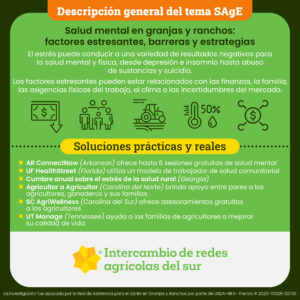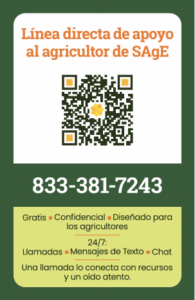Southern Ag Exchange—en Español
Beginning early in 2023, all published SAgE materials have been published simultaneously in Spanish—the current SAgE brochure, research briefs, and the infographics that accompany the briefs. Last fall, the effort began to reproduce the entire website in Spanish. Starting in January of this year, the SAgE webinars have included Spanish interpretation, and Spanish interpretation is available for callers to the SAgE Hotline.

Spanish translation has been a priority from the outset largely because the Southern region includes Puerto Rico. But in addition to that, stress assistance resources, trainings, and research need to be available to all farmers, ranchers, and agricultural workers across the south in their native language, whether it’s English or Spanish.
SAgE has contracted with Full Circle Interpreting for both textual translation and interpretation services for webinars and other events. SAgE team member Egla Delvo-Lopez—extension assistant, cultural integration coordinator, and PhD student—provides additional translation support on shorter documents. Egla and the Full Circle team worked together to create a SAgE glossary of terms so that key phrases such as “farm stress,” “agricultural workers,” and others are translated consistently across documents and platforms.
Applied Research
 Some of the earliest documents to be translated were SAgE’s research briefs. Dr. Andy Smolski, Director of Applied Research, says, “Communication is key for building stronger communities and sharing information. Because of the large number of Spanish-speaking farmers, ranchers, and farmworkers in the southern region, we have made it a primary goal to assure translation of materials and simultaneous interpretation of events to increase the effectiveness of our engagements and construct connections across language. We are also conducting research in Spanish to identify culturally relevant ways to adapt resources.”
Some of the earliest documents to be translated were SAgE’s research briefs. Dr. Andy Smolski, Director of Applied Research, says, “Communication is key for building stronger communities and sharing information. Because of the large number of Spanish-speaking farmers, ranchers, and farmworkers in the southern region, we have made it a primary goal to assure translation of materials and simultaneous interpretation of events to increase the effectiveness of our engagements and construct connections across language. We are also conducting research in Spanish to identify culturally relevant ways to adapt resources.”
The University of Kentucky’s BARN Farm Dinner Theatre curriculum, a SAgE-funded project, has been translated into Spanish but has not been used with a Spanish-speaking audience yet. Ultimately, the Spanish research Dr. Smolski references will inform the creation of programs and curricula in Spanish, rather than translating programs that were created for English speakers.
The Website
When it came to the website, an option to have a Spanish section of the English website was rejected in favor of creating a separate Spanish site. “People tend to first search in their native language,” Egla argued, “and as such, we should have a standalone, dedicated Spanish URL.”
The translated site, Intercambio Agrisur, has most but not all of the elements of the English language site, but it is a work in progress. The goal is to go beyond simply the translation of the English words on the site, Egla says: “All aspects would be in Spanish, down to the tiny print at the bottom as well as metadata descriptions, metatag titles, alt text for images, contact pages, newsletter sign-up forms, and error messages. Having correct metadata translation is important because it can help to enhance search engine results since search engines default to users’ native tongue.”
A Moving Target
Text is continuously created that needs to be translated if SAgE is to be fully bilingual, making the translation process a moving target. Social media, press releases, newsletters, and other content of that nature are currently not translated, but that is a goal.
The hotline, likewise, currently offers Spanish interpretation (and other languages) to callers, but not a Spanish-speaking operator—yet. Hannah Brinson, SAgE’s Strategic Projects Specialist, says that the outreach strategy for the hotline is in both English and Spanish, including hotline cards in both languages. And, she says, “We have a budget line for a full-time Spanish speaking hotline specialist as we document the need through the number of Spanish speaking callers.”
There are pockets of farmworkers across the south who speak other languages as well, such as Karen and certain native languages spoken in Mexico. Dr. Smolski adds, “As we identify those needs and funds to support them, we can support those farmers and farmworkers from other linguistic communities.”
